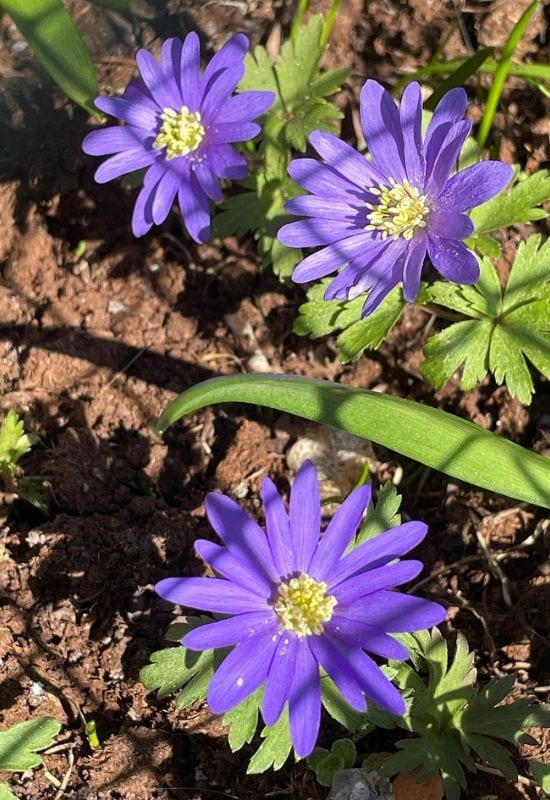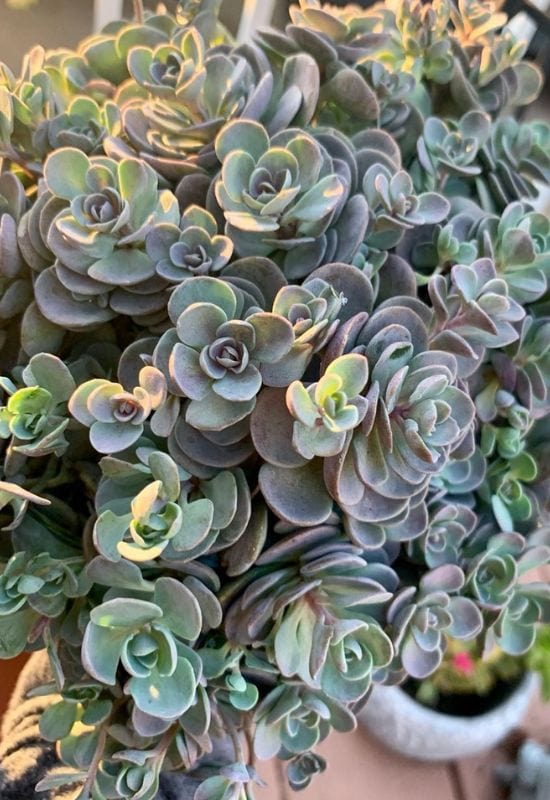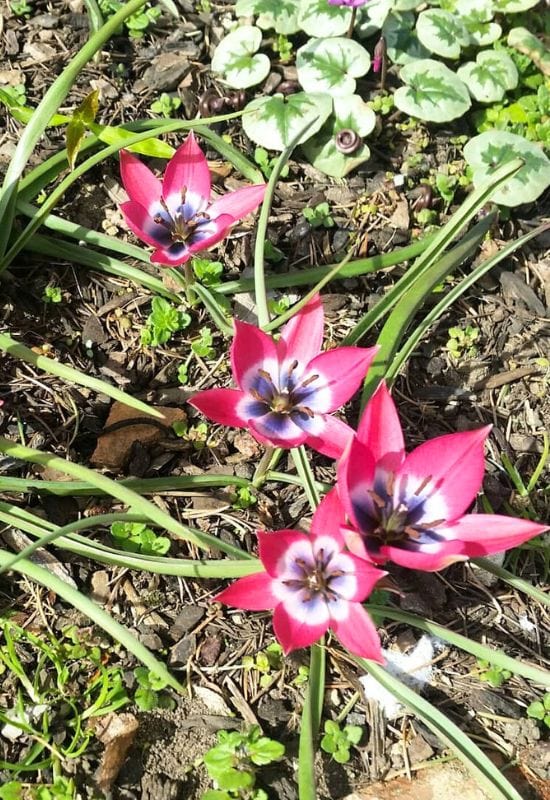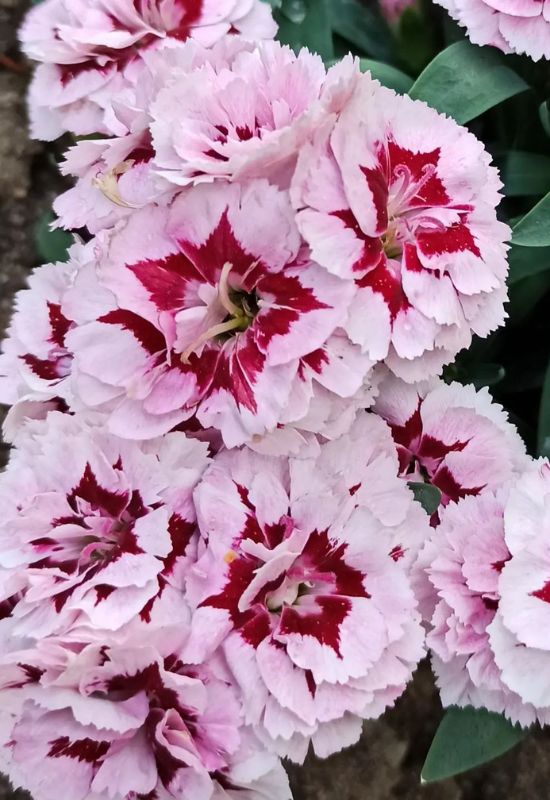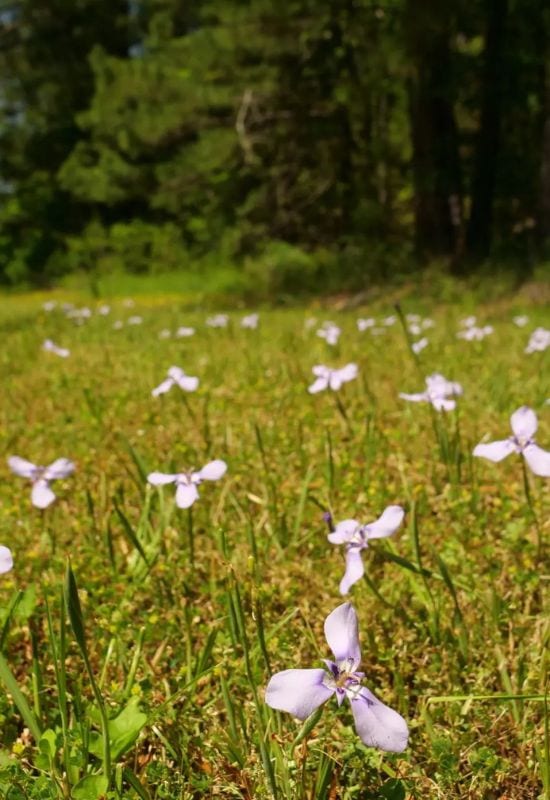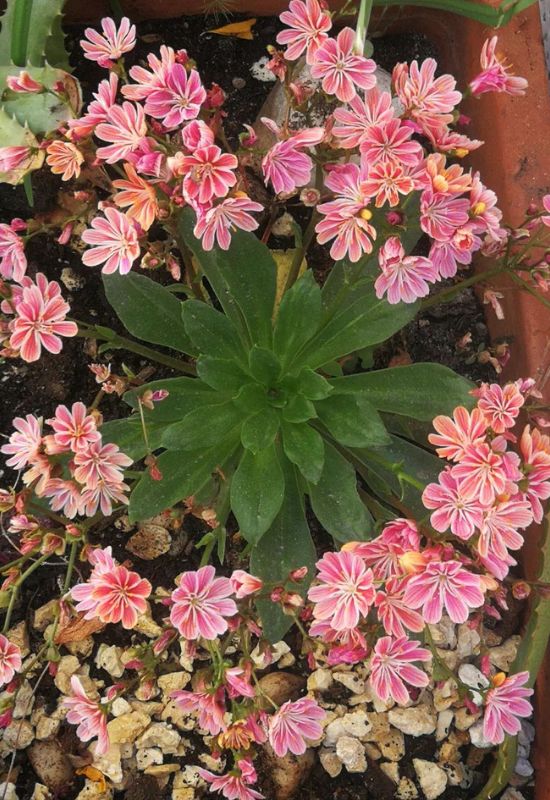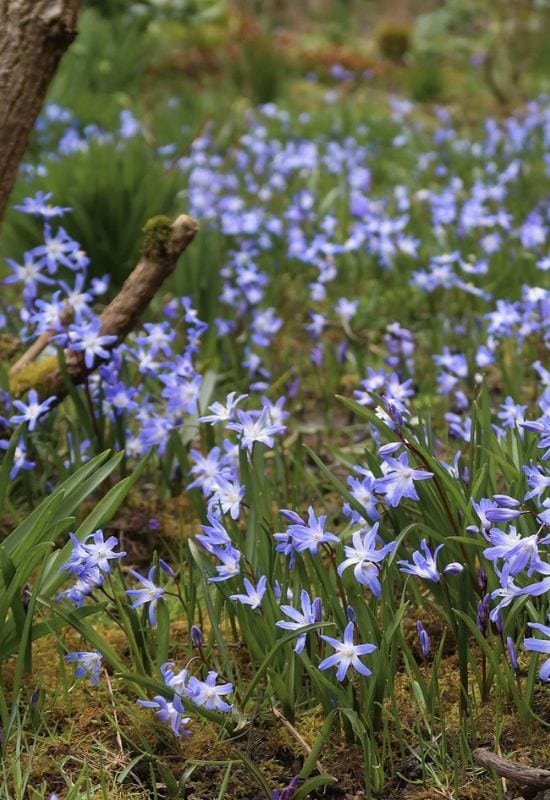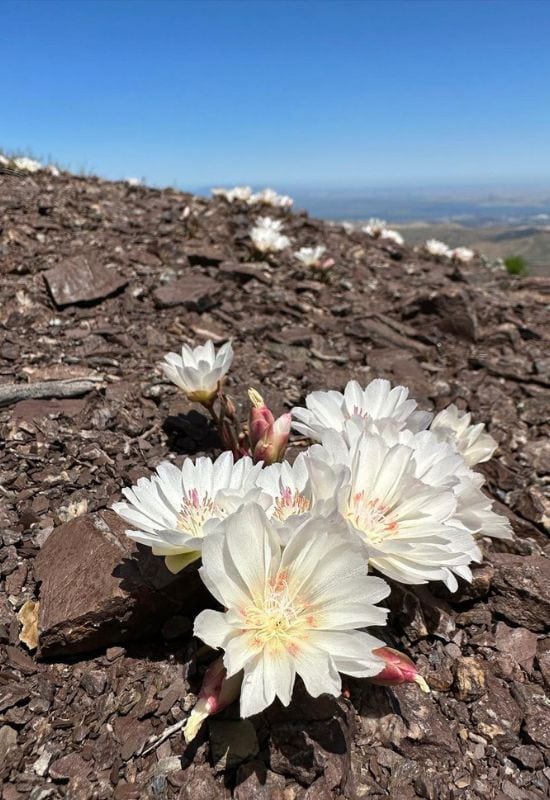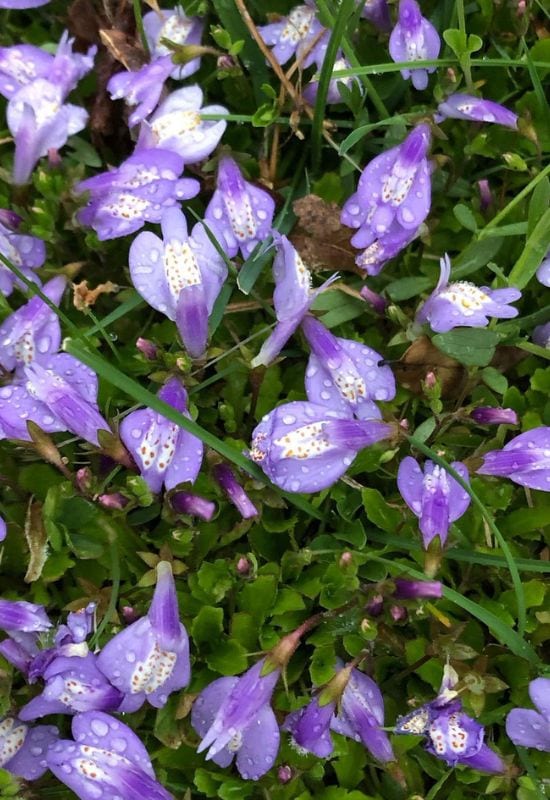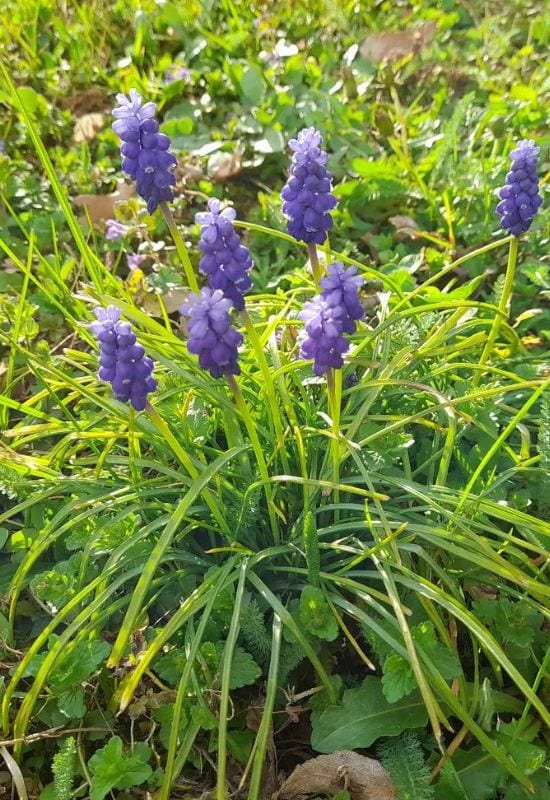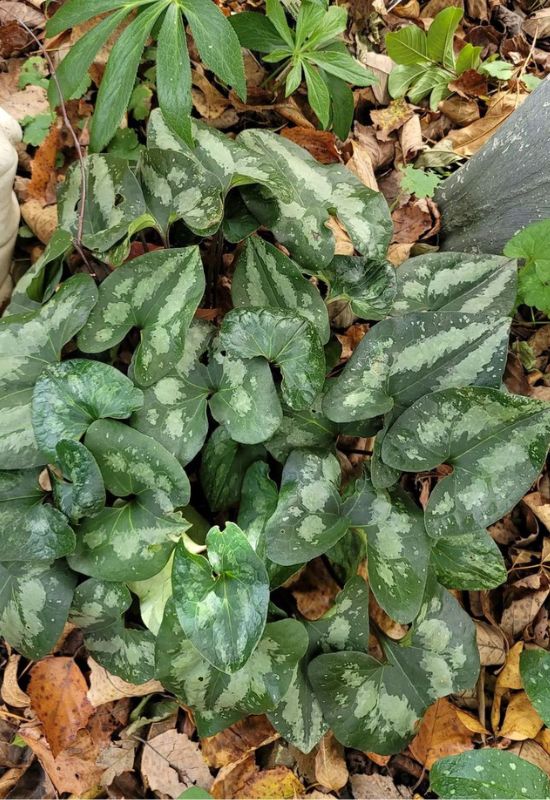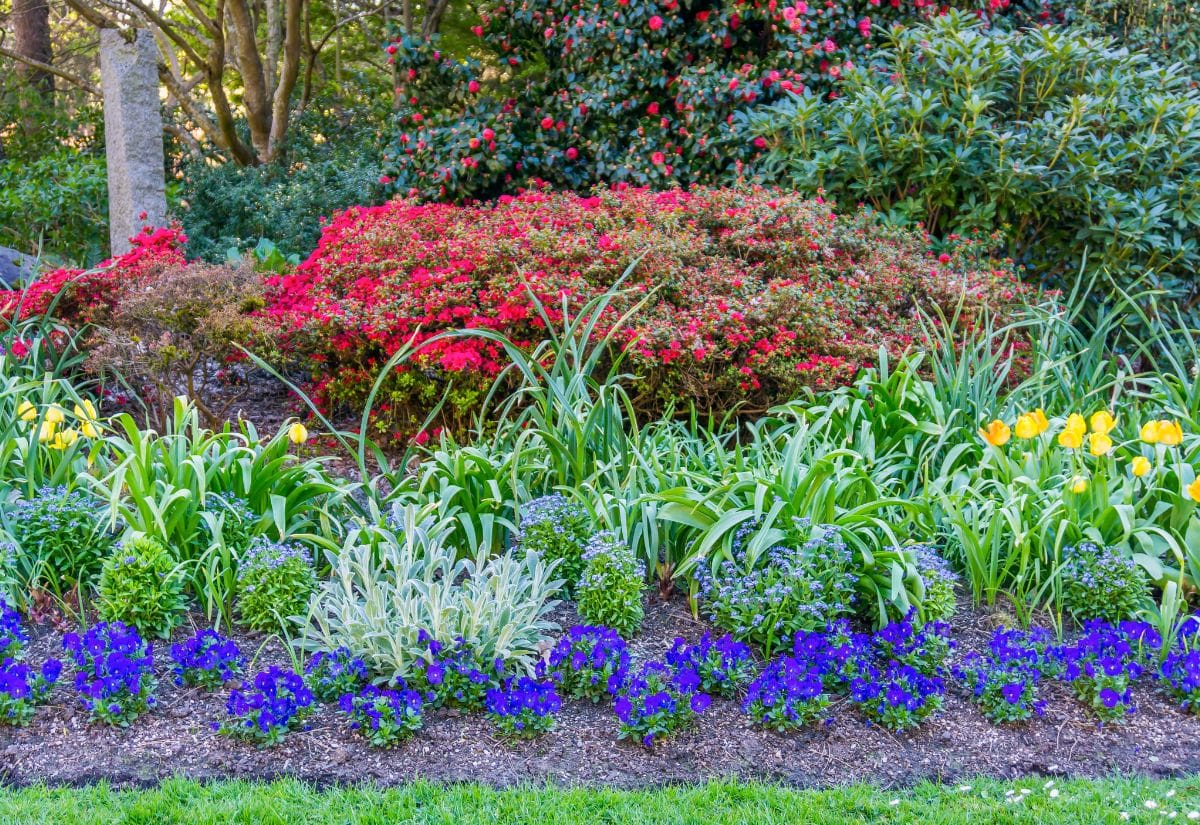
Creating a harmonious and aesthetically pleasing garden requires a symphony of layers, commencing from the ground up. Low-growing perennials play a vital role, infusing your garden beds, walkways, paths, and borders with with a symphony of vibrant blooms, intriguing forms, and a textured foliage tapestry at the very base, all hugging the earth. Best of all, they return to grace your garden year after year!
Although modest in height, these short perennials are bursting with character, providing immense value to gardens, yards, and naturalized areas. They are the finishing touch, the element that ties the garden’s design together.
Ideal for planting under shrubs and roses, these perennials work wonders for rookeries, borders and edging, and some can even spread into lovely living and blooming carpets for ground cover! What’s more, they also serve as a cozy refuge for small creatures, adding to the garden’s ecological value.
Every short perennial we’ll introduce you to today stands no taller than a foot (30 cm), yet each one possesses a charm as mighty as a titan and beauty as mesmerizing as a regal princess. We’ve choosen some of the smallest – yet most breathtaking – varieties out there!
Despite their compact size, these perennials prove to be invaluable additions to your garden – or any garden for that matter. Let me tell you why!
How to Utilize Low-Growing Perennials In Your Garden Design
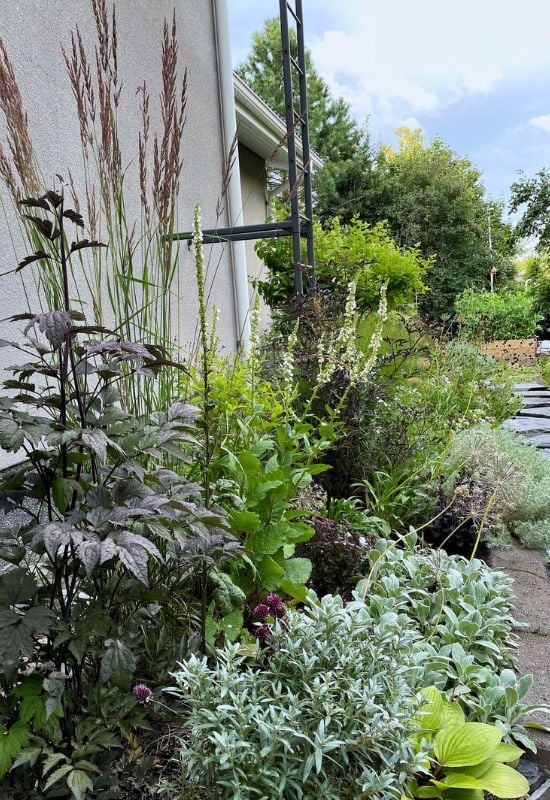
Big plants have a major effect in gardens, but low growing perennials are no less useful. In fact, you could even design, “build” or better grow your garden from the ground up… Let’s see why you should always have some short varieties in your green space.
for Eye Level
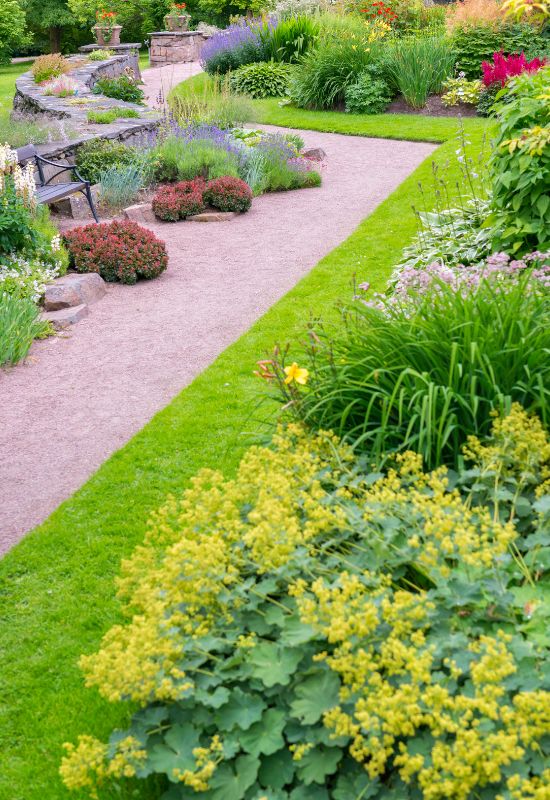
Designing a garden has a lot to do with art. You can use low growing perennials to direct the viewer’s eye down, to ground level. Now, think about a carpet in a room. If you have one, your visitors will look both down and up, and the room will look bigger and even fuller.
The same applies to small perennials, especially if brightly colored and flowering. You don’t want to waste that space under your feet: you want it to be fully part of your garden, and make the best of it.
Also, think that we “measure” the size of a space, of a garden, by the time it takes us to look at it! See the trick? If your visitors spend time looking down at beautiful flowers and foliage, they will subconsciously think your garden is bigger than it actually is.
And there’s more.
To Bring the Garden Together
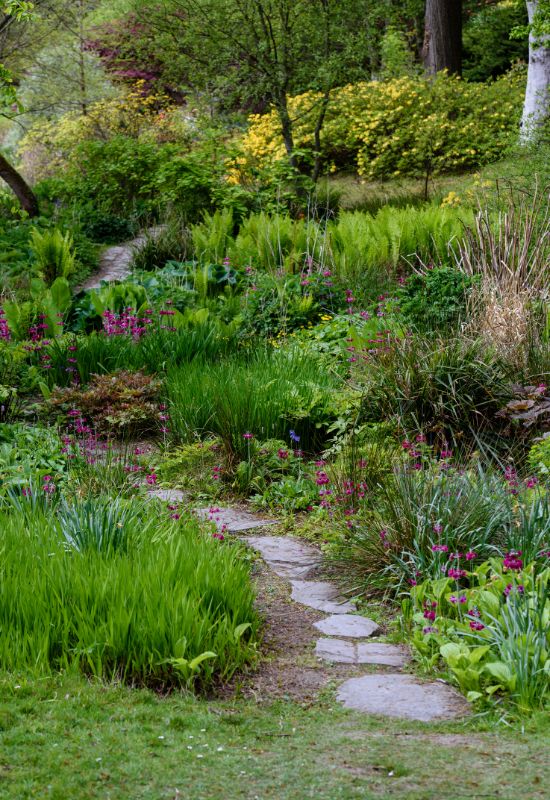
When the soil is covered in plants, like low growing perennials, it gives a sense of continuity and unity to your garden. A shrub here and a tree there, with bare soil (never!), mulching and even a lawn gives you a sense of “separation” of discrete plants on an empty space.
To start with, it does not look very natural; secondly, it looks like “a plant here and a plant there”, not a uniform and coherent space…
Frame The Flower Beds and Borders
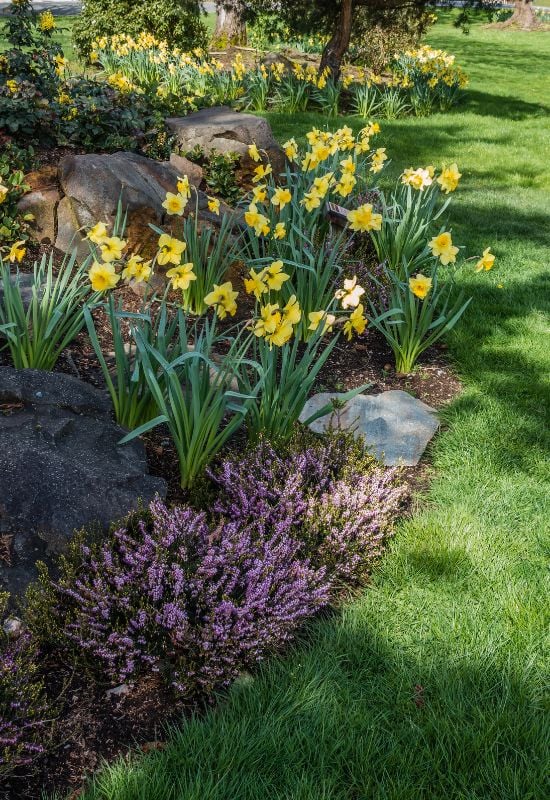
Both flower beds and especially borders should have a series of levels, and short growing perennials belong to the first one, down to the ground. Now, while you can have beds at one single eye level, borders must have progression…
You want low growing perennials (annuals, etc.) at the front, and then go up and up with your plants’ height as you get to the back of your border.
Plant Them Under Shrubs
Roses, camellias and azaleas are wonderful shrubs, but there is no reason why you should not grow some short perennials at their feet. You can mulch, of course, but putting a spark of color here and there will add to the decorative value of your flowering bushes.
To Attract Bees And Butterflies
Small animals that are very useful to gardens want some shelter, low down where they live. I am talking about insects, but also little mammals, like hedgehogs, for example. They feel threatened by predators, and low growing perennials, together with shrubs, can crate corridors for them to move around your garden.
Use Them As Ground Cover
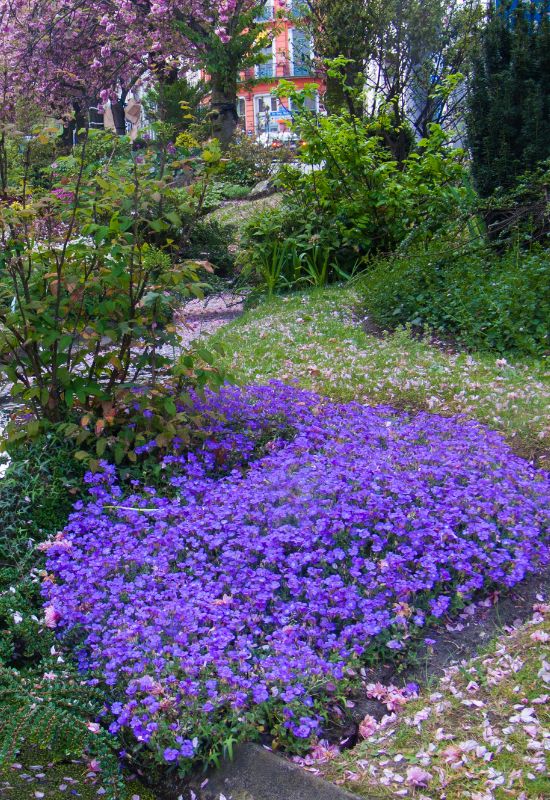
Some low growing perennials are also good for ground cover. Not all, and there are many spreading and prostrate shrubs that can help you as well. It all depends on their life cycle.
A crocus, for example, will only last a few weeks, and its leaves are so thin that… If it does cover the ground, as happens on Alpine pastures once a year (what a spectacle!), it is not a long term solution.
Others like sedum or creeping phlox, on the other hand, are just perfect to keep the soil covered, beautiful and healthy!
They are Perfect For for Rock Gardens
Low growing perennials are a must have in rock gardens. They allow you to see the stones, they grow well between them and they even belong to the same dimensional level.
What is more, they play that interesting and natural looking game of rocks and plants, mixing and overlapping… Just what you need in a rookery.
Showy Combination Containers
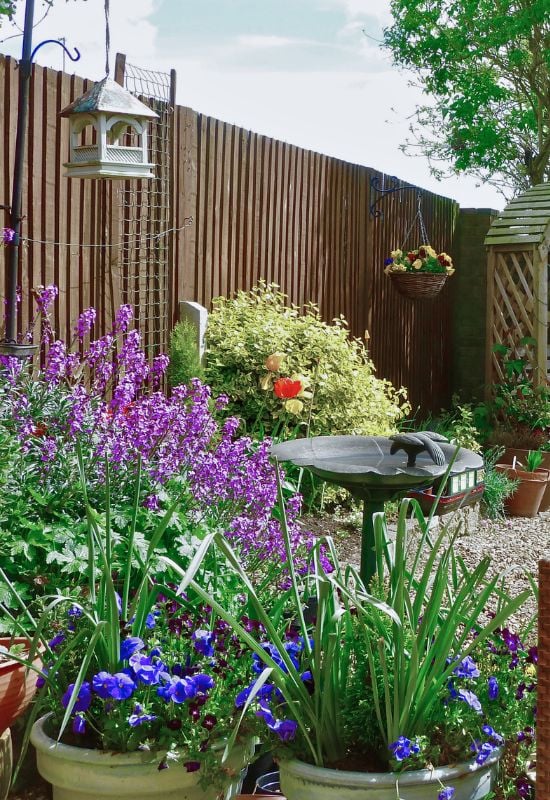
Finally, you can easily fit low growing perennials in pots and containers. This has the added advantage that you can be flexible with your garden layout. If a plant fails in one of your borders and beds, you can move your little potted plants there, and you fill the gap!
You see, low growing perennials are very useful for gardening, so now let’s have a look at a selection for you!
15 Low-Growing Perennial Plants to Frame Your Garden with Elegance
There are rally many low growing perennials you can grow in your garden, so we had to select a few, among the most famous, the most beautiful, some strange looking ones and all low maintenance!
Short but beautiful, and, even more importantly, very useful for your garden, here are 15 low growing perennial varieties for you!
1: Crocus (Crocus spp.)
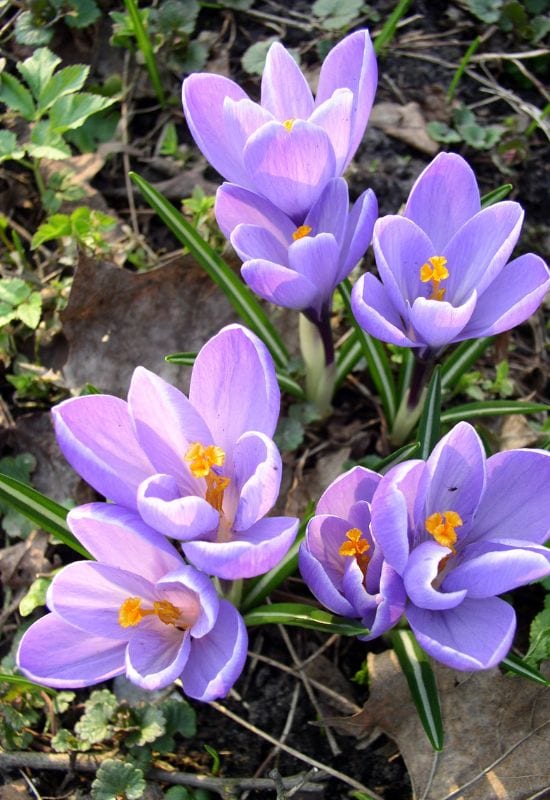
One of the lowest and sweetest flowering perennials is crocus, growing to a maximum of 4 inches (10 cm). Their cupped, almost bell shaped flowers look up from the ground early in spring, announcing the good season.
They also remind us of how beautiful the first humble buds and leaves are, when they pop out of the humid ground… The main color range has white, yellows, blues, lots of violets and some purple, and there are really loads of varieties to choose from. The thin, needle like leaves are delicate and elegant at the same time, not showy for sure, but elegant.
You can grow and naturalize crocuses under trees and shrubs, in flower beds and rock gardens. These little perennials are so low in maintenance that most of what you need to do is plant the bulbs, then they will come back year after year with the first blossoms of the season!
2: Grecian Windflower (Anemone blanda)
Grecian windflower is a low growing Anemone variety with a peaceful and cheerful personality, which never tops 9 inches in height (22 cm). It forms little carpets with its finely textured, deep green foliage and deeply cut leaves.
The blooms are really plentiful and daisy like, with many long petals and a small yellow center. They can be white like in the cultivar ‘White Splendor’, mauve like with ‘Charmer’ or light lavender in ‘Pink Star’.
But maybe my favorite is ‘Blue Star’ with azure to sky blue flowers that look up to you like many candid and happy eyes!
Blooming early in the season, Grecian windflower is perfect as ground cover, because the leaves will stay on till late in the season; it is equally adaptable to low beds and borders, under trees and shrubs and in rock gardens. It also naturalizes easily!
3:‘Blue Elf’ Stonecrop (Sedum ‘Blue Elf’)
Most Sedum varieties are low growing, but we wanted to talk about a very special one for your garden: ‘Blue Elf’ stonecrop, a dwarf at 3 inches in maximum growth (7.5 cm).
Yes, the little round leaves that form lovely succulent rosettes are blue, with a touch of pink, quite often, and an overall icy look.
This way it will draw your eyes down to the ground thanks to its unusual color, and also make it look further away, because this chromatic range “recedes”, as artists say! It will also bloom regularly with fragrant star shaped dark pink flowers in clusters on stems!
‘Blue Elf’ sedum will keep the foliage on in winter and it is quite cold hardy for a succulent. It propagates fast and you can use it as ground cover, in beds, borders, containers and rock gardens.
4: ‘Little Beauty’ Botanical Tulip (Tulipa humilis ‘Little Beauty’)
Not all tulips have ling and tall stems, botanical varieties are short, and the amazing ‘Little Beauty’ only grows to 6 inches tall (15 cm)!
The flowers open fully to a star shape, and they petals start off blue at the center, the fade to almost white in the middle, finally turning bright magenta towards the tips!
The big purple brown anthers complete this unique color display. The long, blade like green foliage, finally, completes the show and sets the blooms off perfectly well.
It is no surprise that this cultivar has won the famous Award of Garden Merit by the Royal Horticultural Society.
‘Little Beauty’ is an exceptionally decorative low variety of tulip you can grow in beds, borders, containers or rock gardens. It will surely become a topic of conversation with your visitors, given its unique palette.
5: ‘Raspberry Surprise’ Pink (Dianthus hybrid ‘Raspberry Surprise’)
Growing no taller than 10 inches (25 cm), this Dianthus perennial, ‘Raspberry Surprise’ pink will amaze you. The frilled flowers come in great numbers for months on end, and they are really heady with their spicy scent!
And then the color… It has rose pink petals with a showy burgundy center! It is one of the best low perennials for fragrance and a brightly colored display ever.
The thin, pointed leaves are decorative as well, thanks to their thick but fine texture and bluish green color. Other varieties will keep short, but this hybrid is particularly beautiful.
‘Raspberry Surprise’ pink will brightenup containers, rock gardens, beds and borders requiring low maintenance and offering you a very strong and pleasant aroma as well.
6: Prairie Nymph (Herbertialahue)
Also called Chilean iris, because it really looks like one of these famous perennials, prairie nymph is a low growing and original looking little plant. From high above its maximum height of 12 inches (30 cm), the blooms look like three helicopter blades, but with a decorative twist.
Pale violet, almost white, this shadeintensify to dark and saturated forming an artistic set of spots and patches towards the center. Three smaller, triangular petals with a similar color pattern hold the reproductive organs in the middle.
They open in the morning and close in the afternoon, while the blade like, green foliage will keep you company after sunset.
Ideal for rock gardens, prairie nymph is an unusual looking low growing perennial to add originality to your garden, also in containers.
7: Creeping Phlox (Phlox subulata)
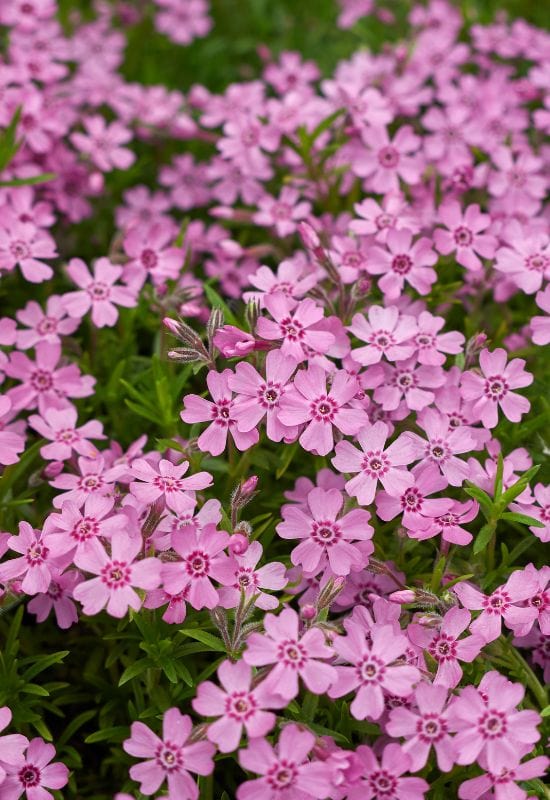
A favorite herbaceous and low growing perennial is creeping phlox, and if you wonder why… It literally becomes a carpet of fragrant flowers, so tightly packed together that you cannot see the foliage when it is in bloom!
All within 5 inches, or 12.5 cm, from the ground. The roughly star shaped but notched blossoms vary un color according to the variety, from white to purple, with many pink, violet, magenta and even blue cultivars.
It is hard to achieve such a bright and showy effect with a plant they requires little maintenance! The foliage will keep your garden interesting at soil level all through the year, as it is evergreen.
Creeping phlox looks its best when it drapes stones, like in rock gardens or over paving stones and even crawling off containers or over flower bed edging.
8: Cliff Maids (Lewisia cotyleidon)
Also called Siskioulewisa, cliff maids is a low growing perennial, at 5 inches tall, or 12.5 cm, from rocky subalpine regions of Oregon and California, and a real, if less known, garden beauty.
At the base, it forms a rosette of spoon shaped, fleshy green leaves and you will soon see the lovely blooms on stems above it. These are showy, pink white or orange, sometimes with striped multicolor arrangements.
The dense clusters will last all through the season as well! It mixes the exotic with the temperate in its personality, and for this reason it is really unique.
As we said, cliff maids likes rocky soil, and this makes it ideal for rock gardens but also container and at the edges of flower beds. It has also won the Fleuroselect Gold Medal.
9: Glory of the Snow (Chinidoxaforbesii)
Blooming in early spring, this small perennial, glory of the snow, is a perfect companion to crocuses, daffodils and snowdrops! Flowering on top of a short stem of between 4 and 10 inches (10 to 25 cm) the star shaped flowers range in color from to blue and magenta pink, depending on the variety you choose.
They are quite bright, and, even if they are not big, they are showy. Each bulb will only produce 2 to 3, partly erect long and fleshy leaves that accompany the bouquet of blossoms at the top.
It is yet another small plant that naturalizes and propagates very easily, so, a little initial investment can lead to a massive display over the years.
Glory of the snow is great for underplanting shrubs and trees, but it will suit most of the uses of low growing perennials, including at the front of borders, in beds, and in rock gardens. While you can grow it un containers as well, it’s not its best use, because it won’t propagate and naturalize there.
10: Bitter Root (Lewisia rediviva)
A close relative of cliff maids, bitter root will keep so close to the soil that the blooms virtually rest on it, in fact, the whole plant is a dwarf of maximum 2 inches, or 5.0 cm!
Reminiscent of some succulent flowers, they are about 2 inches across (5.0 cm) with many sword like petals and very bright indeed. White, rose pink, magenta or lilac, they appear from copper red buds quite generously in early spring and they keep coming till about June!
The little leaves are succulent looking, needle like, long and thin, and they form lovely green carpets which too, never grow more than a few inches in height.
Native of western North America, bitter root is ideal for rock and gravel gardens, but if you need to fill a few containers with this low lying beauty, go ahead!
11: Creeping Mazus (Mazus reptans)
This semi evergreen low lying perennial, creeping mazus, is quite unusual and interesting for a different herbaceous touch in your garden. It will only grow to two inches, or 5.0 cm, but… Blooming for months on end, the flowers are actually tubular, but the big mouths look like butterflies, or little airplanes!
Lavender violet in shade, they also display two long white patches with purplish red to orange yellow dots. These come on a thick layer of small, glossy and bright green leaves that have lobes on the margin, giving you an interesting layer just on top of the soil.
Creeping mazus is ideal as ground cover, but it will also be a great asset in a woodland garden or to underplant roses and shrubs. Yet again, if you have a rock garden, give it a try!
12: Grape Hyacinth (Muscariazureum)
Muscari, or grape hyacinth, is like the smaller version of the fragrant flower it takes its name from. Reaching only 5 inches tall (12.5 cm), it produces clusters of beautiful and tightly packed bell shaped flowers in shades or white to blue, according to the variety.
And they are sweetly scented as well! The fleshy leaves are glossy, upright and long, convex and they grow just. Bot shorter than the inflorescences, forming a crown or slender rosette that frames them perfectly well.
This short spring beauty has deservedly won the Award of Garden Merit by the Royal Horticultural Society.
Yet another short bulbous perennial that will naturalize spontaneously and fill your flower beds or even large areas under trees and shrubs, forming seas of color once a year!
13: ‘Fancy Finch’ Carpet Bugle (Ajuga reptans Feathered Friends ‘Fancy Finch’)
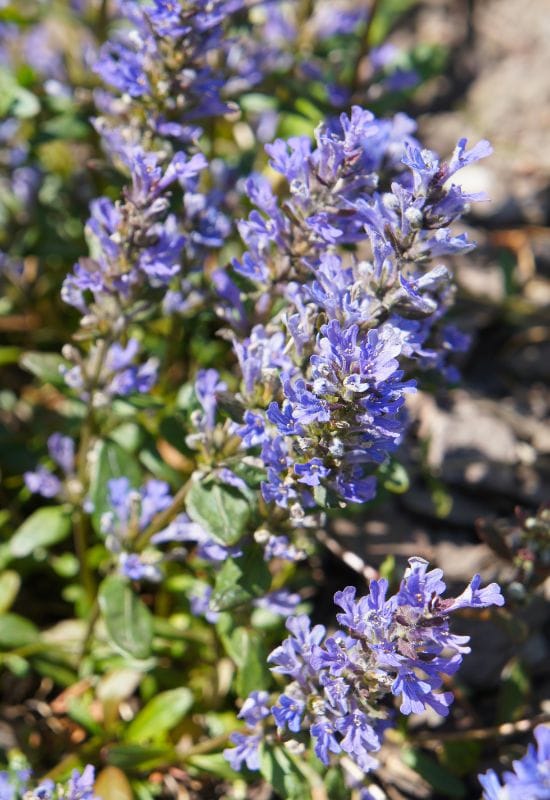
‘Fancy Finch’ carpet bugle is the low growing perennial you need to bring lots of colors to a shady corner in your garden, all within 6 inches from the roots (15 cm). How does it do it?
The long, tongue like, leaves form very dense clumps of gold, bronze, green and purple, because they have an impressive chromatic range. And they are evergreen as well!
Fast growing and low maintenance, it also has beautiful cobalt blue flowers that open un dense clusters on short stems! The contrast could not be more striking, and this floral display can last through both winter and summer!
Perfect under trees and shrubs, ‘Fancy Finch’ carpet bugle is ideal for woodland gardens; it will soon provide ground cover as well as color and interest all year round.
14: Dwarf Iris ‘Gordon’ (Iris reticulata ‘Gordon’)
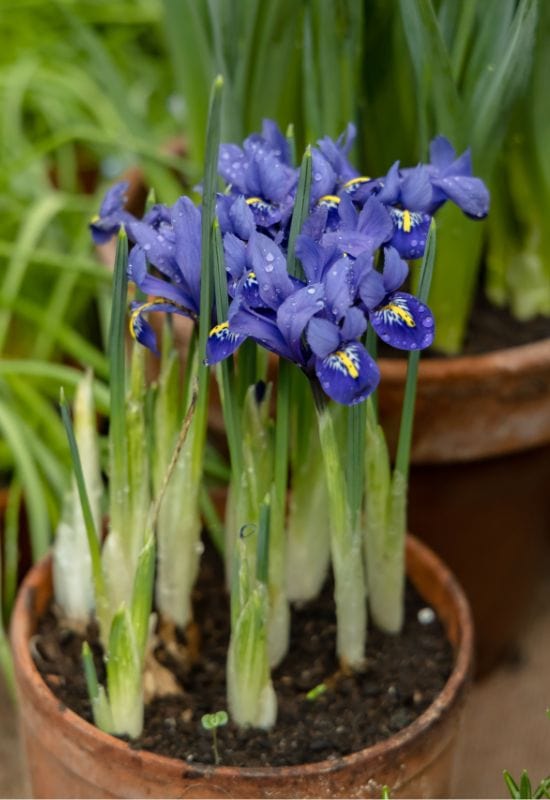
We picked a very special cultivar of dwarf iris for your garden: ‘Gordon’ only grow to 6 inches tall (15 cm) but… Its blooms are a real spectacle!
Thefalls, or lower petals are strong and dark blue violet at the margins; which a white towards the base, the signal (yellow patch) is saffron to dark gold, very marked and with blue spots.
The standards, or upper sepals, are bright sky blue with darker veins in them! Elegant and showy at the same time, these spectacles open on top of thin stems and flanked by slender, long and pointed bright green leaves. And there’s a final surprise, this variety will blossom in winter, even through the snow!
‘Gordon’ dwarf iris will propagate fast, and it can be a unique sight when it blossoms in your beds, borders, containers or rock gardens when all the landscape is white with snow!
15: Chinese Wild Ginger (Asarum splendens)
We can close this journey at low altitude with a small but very beautiful little perennial: Chinese wild ginger. The semievergreen leaves keep down, very close to the ground, and they are sagittate in shape, like spear heads, broad, pointed and very dark Sacramento green with brighter patches, almost silver in shade.
Under the clumps that the foliage form of about 5 to 8 inches in height (12.5 to 20 cm), you will find dark, chocolate brown and cup shaped flowers that reach about 2 inches wide (5.0 cm). Ideal for a shady corner of your garden, this unusual native of China is a really precocious looking little wonder!
You can grow Chinese wild ginger in containers, but also in beds and borders. This perennial too is good as ground cover and under shrubs and trees, especially if you have a poorly lit garden.
Looking down to perennial garden wonders
Short and humble, these low growing perennials are really wonderful indeed! There are more to choose from, but always remember how useful these tiny green beauties are for your garden, to make it look better, more united, to keep it healthy and even to make it look, ironically, even bigger!

Written By
Adriano Bulla
After many years as an academic in London, Adriano Bulla became a writer, publishing books like A History of Gardening, Organic Gardening and Elements of Garden Design; he then decided to become a gardener, following his childhood dream, and has been following his dream writing and gardening professionally in Southern Europe, where he has specialized in new and innovative organic gardening fields and techniques, like permaculture, regenerative agriculture, food forests and hydroponics.

